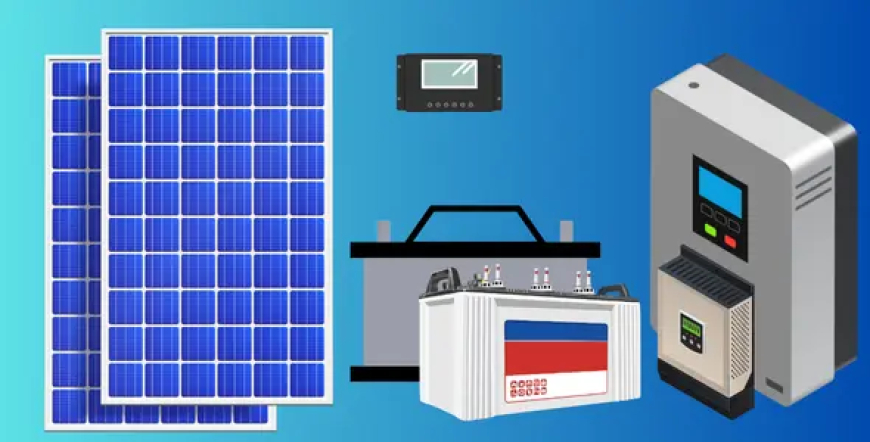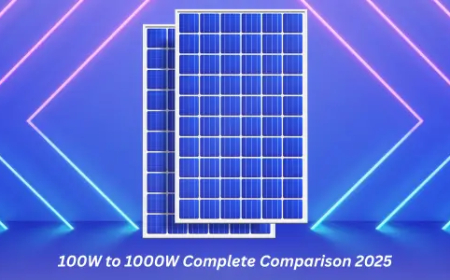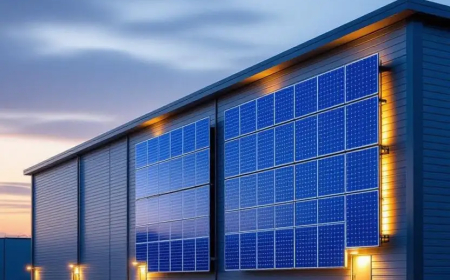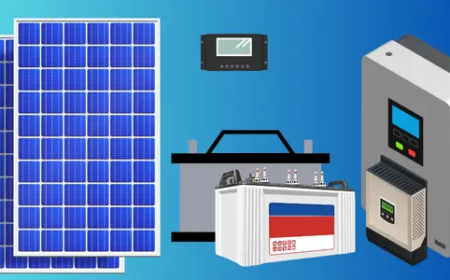Solar Panel Kit with Battery & Inverter Guide 2025
Discover everything about complete solar panel kits with battery and inverter. Learn about off-grid systems, installation, top brands, costs, and how to choose the perfect solar power kit for your needs.

Are you considering energy independence and looking for a complete solar solution? A solar panel kit with battery and inverter offers everything you need to generate, store, and use renewable energy in one comprehensive package. This guide explores the essential components, benefits, installation considerations, and top options available in 2025.
What is a Solar Panel Kit with Battery and Inverter?
A complete solar panel kit with battery and inverter is an all-in-one renewable energy solution that combines all essential components needed to harness solar power. These comprehensive systems include solar panels to capture sunlight, batteries for energy storage, inverters to convert DC power to AC power, and charge controllers to regulate the charging process.
Unlike purchasing individual components separately, these integrated solar kits ensure compatibility between all parts, simplify the installation process, and provide a cost-effective path to energy independence. Whether for residential homes, RVs, cabins, or off-grid applications, these complete systems deliver reliable, sustainable power.
Essential Components of Complete Solar Kits
Understanding each component helps you make informed decisions when selecting your solar power system:
Solar Panels
The heart of any solar energy system, photovoltaic panels convert sunlight into direct current (DC) electricity. Modern kits typically include monocrystalline or polycrystalline panels ranging from 100 watts to 400 watts per panel. The total wattage depends on your energy requirements and available installation space.
Premium solar panels feature high-efficiency cells, weather-resistant construction, and warranties extending 25 years or more. Many kits include multiple panels that can be connected in series or parallel configurations to achieve desired voltage and amperage.
Solar Batteries
Battery storage is crucial for using solar power when the sun isn't shining. Lithium-ion batteries have become the standard in modern solar kits due to their superior energy density, longer lifespan, and deeper discharge capabilities compared to traditional lead-acid batteries.
Battery capacity is measured in amp-hours (Ah) or kilowatt-hours (kWh). A typical residential battery ranges from 100Ah to 200Ah for smaller systems, while larger home installations may use batteries with 5kWh to 15kWh capacity. Quality lithium batteries can last 10-15 years with proper maintenance.
Power Inverters
Solar inverters are essential for converting the DC electricity generated by panels and stored in batteries into alternating current (AC) electricity that powers household appliances and electronics. Modern solar kits include either pure sine wave inverters or modified sine wave inverters.
Pure sine wave inverters produce clean, stable power identical to grid electricity, making them suitable for sensitive electronics, medical equipment, and all household devices. They're more expensive but offer superior performance and compatibility. Inverter capacity typically ranges from 1000W to 10,000W or more, depending on your power needs.
Charge Controllers
The charge controller regulates power flowing from solar panels to batteries, preventing overcharging and extending battery life. Two main types exist: PWM (Pulse Width Modulation) and MPPT (Maximum Power Point Tracking) controllers.
MPPT charge controllers are more efficient, especially in larger systems or varying weather conditions, capturing up to 30% more power than PWM controllers. They're included in premium solar kits and justify their higher cost through improved performance and faster charging times.
Types of Solar Panel Kits with Battery and Inverter
Different applications require different system configurations. Understanding these options helps you select the right kit:
Off-Grid Solar Systems
Off-grid solar kits are designed for complete energy independence, requiring no connection to the utility grid. These comprehensive systems include oversized battery banks to provide power during extended cloudy periods and backup generators for emergency situations.
Ideal for remote cabins, tiny homes, rural properties, and anywhere grid connection is unavailable or prohibitively expensive, off-grid systems require careful sizing to meet all energy needs year-round.
Grid-Tied Solar Systems with Battery Backup
Also called hybrid solar systems, these kits connect to the utility grid while maintaining battery storage for backup power during outages. They offer the best of both worlds: grid connectivity for consistent power and energy independence during emergencies.
These systems can export excess solar energy to the grid through net metering programs, potentially generating credits on your electricity bill while maintaining backup power capability.
Mobile Solar Kits
Designed for RVs, boats, campers, and portable applications, mobile solar kits are compact, lightweight, and easy to install. They typically range from 100W to 400W and include smaller batteries optimized for frequent charging cycles.
Mobile kits often feature flexible or foldable panels, portable battery stations, and compact inverters suitable for powering lights, phones, laptops, small refrigerators, and other travel essentials.
Benefits of Complete Solar Panel Kits
Investing in an all-in-one solar kit offers numerous advantages over purchasing components separately:
Guaranteed Compatibility
Every component in a complete kit is engineered to work together seamlessly. The solar panels, charge controller, battery, and inverter are matched for voltage, current, and capacity, eliminating compatibility issues that can plague DIY systems assembled from mixed components.
Simplified Installation
Complete kits include detailed instructions, mounting hardware, cables, and connectors designed specifically for that system. This streamlined approach reduces installation time, minimizes technical complexity, and decreases the likelihood of errors.
Cost Savings
Purchasing a complete solar kit typically costs 15-25% less than buying individual components separately. Manufacturers leverage bulk purchasing and optimized packaging to pass savings to customers while ensuring quality and performance.
Technical Support
Reputable kit manufacturers provide customer support, installation guidance, and troubleshooting assistance. This support proves invaluable for first-time solar users navigating installation and system optimization.
Warranty Coverage
Complete kits often include comprehensive warranty coverage for all components, providing peace of mind and protection for your investment. Many manufacturers offer 5-10 year warranties on electronics and 25+ year warranties on solar panels.
Sizing Your Solar Panel Kit
Choosing the right system size is critical for meeting your energy needs without overspending. Follow these steps to determine appropriate capacity:
Calculate Daily Energy Consumption
Review your electricity bills or use a power meter to determine your average daily usage in kilowatt-hours (kWh). For off-grid systems, list all appliances and devices you'll power, noting their wattage and daily usage hours.
A typical American home uses 30 kWh per day, though energy-efficient homes may use 10-15 kWh. RVs and mobile applications typically require 2-5 kWh daily.
Account for Solar Production
Solar panels don't produce maximum output continuously. Account for sun hours in your location, seasonal variations, and system losses. A general rule estimates 4-5 peak sun hours daily in most US locations.
Divide your daily energy needs by peak sun hours to determine required panel capacity. For 30 kWh daily usage with 4 sun hours, you'd need approximately 7.5 kW of panels (accounting for 80% system efficiency).
Size Battery Storage
Battery capacity should store 1-3 days of energy usage for grid-tied systems with backup, or 3-5 days for off-grid systems. This provides adequate reserves during cloudy weather or high-usage periods.
For 30 kWh daily usage, an off-grid system might include 100-150 kWh of battery storage, while a backup system could use 30-60 kWh.
Match Inverter Capacity
Your inverter must handle your peak power demand plus a safety margin. Identify your highest simultaneous power draw by adding up appliances that might run concurrently. Add 20-30% capacity buffer for surge currents when motors or compressors start.
Top Brands for Solar Panel Kits 2025
Several manufacturers have established reputations for quality complete solar kits:
EcoFlow
EcoFlow specializes in portable power stations and solar generators, offering integrated solutions with advanced battery management systems. Their kits feature fast-charging capabilities, expandable capacity, and user-friendly mobile apps for system monitoring.
ECO-WORTHY
Known for affordable, reliable solar kits, ECO-WORTHY provides complete systems ranging from 200W starter kits to multi-kilowatt residential installations. Their kits include quality lithium batteries, pure sine wave inverters, and comprehensive installation accessories.
SunGoldPower
SunGoldPower offers premium complete solar kits designed for both residential and commercial applications. Their systems emphasize easy setup, expandability, and reliable off-grid performance with quality components and excellent customer support.
EG4 Systems
Available through Signature Solar, EG4 Systems provides high-performance solar kits with advanced hybrid inverters, modular battery systems, and professional-grade components suitable for serious off-grid or backup applications.
Generac
A trusted name in backup power, Generac's solar and battery solutions integrate seamlessly with their generator products, offering comprehensive energy security. Their PWRcell systems feature modular battery design and intelligent load management.
Installation Considerations
Successful solar kit installation requires planning and attention to detail:
Site Assessment
Evaluate your installation location for optimal sun exposure, avoiding shading from trees, buildings, or other obstructions. South-facing orientations in the Northern Hemisphere maximize energy production. Consider seasonal sun angles when planning panel placement.
Mounting Options
Choose between roof mounting, ground mounting, or portable setups depending on your application. Roof installations save space but require structural evaluation, while ground mounts offer easier maintenance and adjustment but consume yard space.
Electrical Requirements
Ensure your installation complies with local electrical codes and regulations. Many jurisdictions require permits for solar installations, and some mandate professional electrician involvement for grid-connected systems.
Safety Precautions
Solar installations involve electrical work and potentially working at heights. Use appropriate safety equipment, follow manufacturer instructions carefully, and consider professional installation for complex or large-scale systems.
Cost Analysis and ROI
Understanding the financial aspects helps justify your solar investment:
Initial Investment
Complete solar panel kits with battery and inverter range from $500 for basic portable systems to $30,000+ for comprehensive whole-home installations. Mid-range residential kits typically cost $3,000-$10,000, while quality off-grid systems run $10,000-$20,000.
Federal and State Incentives
The federal solar Investment Tax Credit (ITC) provides a 30% tax credit on solar system costs through 2032. Many states offer additional rebates, tax credits, and incentive programs that significantly reduce net costs.
Energy Savings
Calculate your payback period by dividing net system cost by annual energy savings. With average electricity rates of $0.15-$0.30 per kWh, systems often pay for themselves within 5-10 years while providing 25+ years of service.
Increased Property Value
Studies show solar installations increase home values by approximately 4%, often exceeding the system cost and providing immediate return on investment when selling.
Maintenance and Longevity
Proper maintenance maximizes system performance and lifespan:
Panel Cleaning
Clean solar panels 2-4 times yearly to remove dust, pollen, and debris that reduce efficiency. Use water and a soft brush, avoiding abrasive materials that might scratch panel surfaces.
Battery Care
Monitor battery health through system displays or mobile apps. Avoid deep discharges when possible, maintain appropriate temperature ranges, and ensure proper ventilation for battery installations.
System Monitoring
Modern solar kits include monitoring capabilities showing energy production, battery status, and system performance. Regular monitoring helps identify issues early and optimize energy usage patterns.
Component Inspection
Annually inspect all connections, mounting hardware, and wiring for wear or damage. Check inverter displays for error codes, and verify charge controller operation during various sun conditions.
Frequently Asked Questions
How long do solar panel kits with batteries last?
Solar panels typically last 25-30 years with minimal performance degradation. Lithium batteries last 10-15 years, while inverters and charge controllers generally last 10-15 years. With proper maintenance, complete systems provide reliable power for decades.
Can I expand my solar kit later?
Most quality solar kits are designed for expandability. You can add additional panels, batteries, or upgrade inverters as energy needs grow. Ensure your charge controller and inverter have capacity for future expansion when selecting your initial system.
Do I need professional installation?
Many smaller solar kits (under 1000W) are designed for DIY installation with basic electrical knowledge. Larger systems or grid-tied installations often require licensed electricians and inspections to ensure safety and code compliance.
How much power can these kits generate?
Power generation depends on panel capacity, sun exposure, and location. A 1000W solar kit in optimal conditions can generate 4-5 kWh daily, while larger 5kW systems can produce 20-25 kWh daily during peak seasons.
Will solar kits work during power outages?
Off-grid and hybrid systems with battery storage continue operating during outages. Grid-tied systems without batteries automatically shut down during outages for utility worker safety. Battery backup ensures power availability regardless of grid status.
What size kit do I need for my home?
Average homes need 5-10 kW systems to cover typical usage, though energy-efficient homes may require less. Calculate your daily kWh consumption and local sun hours to determine appropriate system size.
What's Your Reaction?
 Like
0
Like
0
 Dislike
0
Dislike
0
 Love
0
Love
0
 Funny
0
Funny
0
 Angry
0
Angry
0
 Sad
0
Sad
0
 Wow
0
Wow
0





